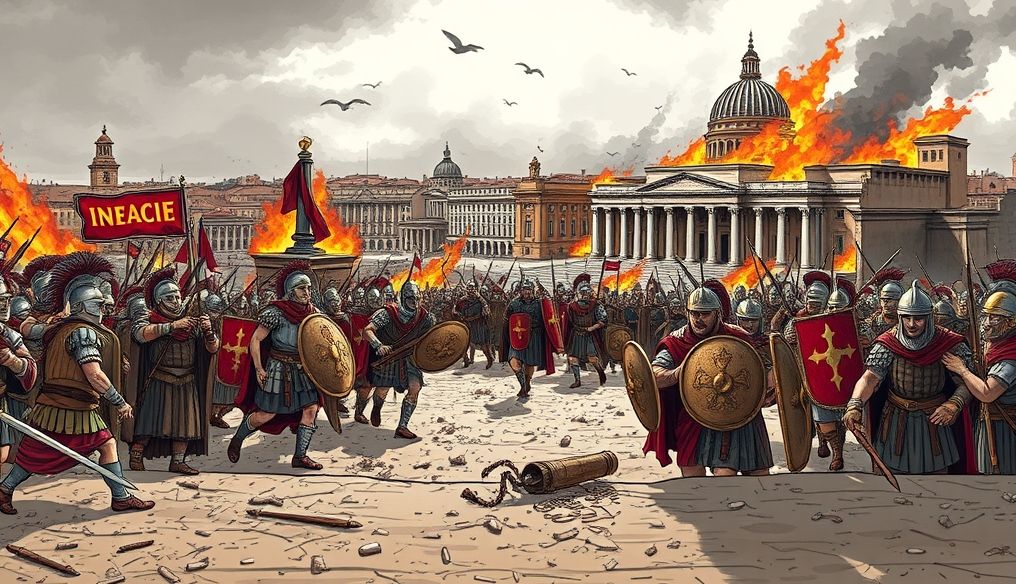What Were the Real Reasons Behind the Fall of the Roman Empire?
The fall of the Roman Empire, a complex and controversial historical period, was not the result of a single cause but rather a combination of numerous factors. It's difficult to pinpoint an exact starting point for the decline, but it can be said that it began to accelerate in the 3rd and 4th centuries AD, culminating in the fall of Rome in 476 AD. To understand this pivotal event in history, we must look at a variety of reasons that contributed to it.
1. Political Instability and Corruption
Political instability and corruption were among the most prominent problems facing the Roman Empire in its final years. Fierce competition for power between generals and politicians resulted in a series of civil wars and coups. Emperors were constantly being killed or overthrown, leading to a power vacuum and an inability to make decisive decisions. Corruption was rampant at all levels of government, leading to the squandering of public resources and weakening public confidence in leadership. For example, during the reigns of bad emperors like Caligula and Nero, the empire suffered from widespread financial corruption and abuse of power.
- Civil Wars: Constant struggles for power.
- Administrative Corruption: Squandering of resources and mismanagement.
- Loss of Trust: Erosion of public confidence in the government.
2. Economic Problems and Inflation
The Roman economy suffered from serious problems in the last centuries of the empire. Constant wars drained financial resources, and taxes on the people increased. Inflation caused prices to rise and the value of currency to fall, damaging trade and the economy in general. The heavy reliance on slaves in agriculture hindered innovation and technological development. In addition, natural disasters such as floods and droughts affected agricultural production and exacerbated economic problems.
In fact, Emperor Diocletian attempted to reform the economic system by issuing the "Edict on Maximum Prices" in 301 AD, but it did not succeed in curbing inflation and instead exacerbated the problems.
3. Barbarian Invasions
Barbarian invasions posed a constant threat to the Roman Empire. Germanic tribes began to put pressure on the empire's borders in the 3rd and 4th centuries AD, taking advantage of the weakened Roman army to invade and plunder border regions. Large migrations of tribes such as the Goths, Vandals, and Huns destabilized the empire and destroyed infrastructure. In 410 AD, the Visigoths sacked Rome, an event that shocked the Roman world and showed how weak the empire had become.
The Visigoths' victory at the Battle of Adrianople in 378 AD, where they defeated and killed Emperor Valens, is considered a major turning point in the history of barbarian invasions.
4. Military Decline
The Roman army, once considered an invincible force, began to decline in the final centuries of the empire. Corruption and inefficiency led to a decline in the quality of training and equipment. The army became increasingly reliant on barbarian mercenaries, who did not have the same loyalty or discipline as Roman soldiers. The weakened army made it difficult to defend the empire's borders against barbarian invasions.
One of the main reasons for the military decline was the policy of recruiting barbarians into the Roman army, which eventually led to a loss of Roman identity within the military.
5. Spread of Christianity
Although Christianity eventually became the official religion of the Roman Empire, its initial spread contributed to the weakening of the empire. Christians refused to worship Roman emperors, leading to conflicts with the authorities. Christianity also led to a shift in people's loyalty from the state to the church, weakening national unity. However, it should be noted that this effect was temporary, as Christianity later became a unifying force in the empire.
The Edict of Milan in 313 AD, issued by Emperor Constantine, allowed religious freedom in the Roman Empire, which accelerated the spread of Christianity.
6. Division of the Empire
In an attempt to better manage the empire, Emperor Diocletian divided it into two parts, East and West, in 286 AD. However, this division exacerbated the problems, as the two parts competed for resources and power. The Western part was weaker than the Eastern part and suffered from greater economic and military problems. In the end, the Western part fell to barbarian invaders, while the Eastern part, known as the Byzantine Empire, continued for more than a thousand years.
The administrative division of the empire, although intended to improve administration, actually led to the dispersion of resources and increased competition between the two parts.
7. Climate Change and Epidemics
Some studies suggest that climate change and epidemics played a role in the collapse of the Roman Empire. Changes in climate may have reduced agricultural production and increased famines. Epidemics, such as the Antonine Plague in the 2nd century AD and the Plague of Justinian in the 6th century AD, reduced the population and weakened the economy.
Archaeological evidence suggests that periods of severe drought significantly affected agricultural production in the Roman Empire.
8. Loss of Roman Identity
Over time, people began to lose their sense of Roman identity. The influx of barbarian immigrants into the empire diluted the original Roman culture. Corruption and political instability eroded people's trust in Roman institutions. The loss of Roman identity made it difficult to unite the people against external threats.
The spread of barbarian cultures within the empire eroded traditional Roman values and institutions.
In conclusion, the fall of the Roman Empire was the result of a complex interaction between political, economic, military, social, and environmental factors. No single cause can be blamed, but rather the whole picture must be looked at to understand this important historical event. Studying the causes of the fall of the Roman Empire can teach us valuable lessons about the importance of political, economic, and social stability, the importance of maintaining national unity, and the importance of preparing to face external challenges.




